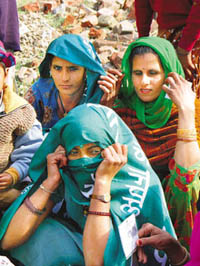Indian health indicators highlight the poor status of women
Indian women continue to face pressure to produce a male child, data from a new survey suggest.

Close to 90 percent of married women with two living children don't want more children if they have at least one son, but that number slips significantly to just more than 62 percent if the women have two girls, according to government survey results released Wednesday.
In some states, such as the poor and underdeveloped Bihar, 80 percent of women with two daughters and no sons wanted to have another child.
Women face great social pressure to produce a male child in this nation where the cultural preference for boys is rooted in the custom of dowry, with families often going into debt to provide gifts for the groom's family.
The numbers show that "we still have much to do to reduce the discrimination against girls and in tackling this son preference," said A.K. Shiv Kumar, a development economist and an adviser to UNICEF.
India's latest census data shows that the preference for boys has skewed the gender ratio in population of more than 1.1 billion people. Experts say that sex-selective abortions are responsible for the number of girls per 1,000 boys slipping from 945 in 1991 to 927 in 2001.
Fresh data from India's National Family Health Survey released Wednesday show that even as the country continues to show strong economic growth, its social indicators are dragging, mostly due to poor access to health care and information. India's economy is likely to grow by 9.2 percent in the fiscal year that ends in March.
In an indication that women lack adequate legal protection, the data released Wednesday show that nearly 45 percent of married women between the ages of 20 and 24 were married before India's legal age of 18. A majority of marriages in India are still arranged by families and this is especially true when men and women are married early.
Also, 16 percent of women surveyed between the ages of 15 and 19 were pregnant at the time of the survey. The numbers also show the health gap between urban and rural India, with women in the countryside getting pregnant much younger.
"This is an indicator of the state of women's health and the overall status of women in this country," said Kumar, adding that it also indicated the low priority health care had in policy planning. India allocates just two percent of its federal government spending to health related expenditure compared to 16 percent in a developed nation like France, according to UNICEF data.
The first set of data was released earlier this month and showed that almost half of India's children suffered from malnutrition, putting the country in the same league as Burkina Faso and Cambodia, reports AP.
Wednesday's additional data showed that close to 80 percent of Indian children between 6 months and 35 months suffered from anemia.
The survey the third conducted since 1992-1993 covers about 230,000 people between the ages of 15 and 54, more than half of them women, and was conducted through face-to-face interviews all across India between December 2005 and August 2006. It has no significant margin of error.
Subscribe to Pravda.Ru Telegram channel, Facebook, RSS!




